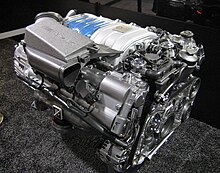Numerous technological innovations have been introduced on Mercedes-Benz automobiles throughout the many years of their production, including:
- The internal combustion engined automobile was developed independently by Benz and Daimler & Maybach in 1886
- Daimler invented the honeycomb radiator of the type still used on all water-cooled vehicles today
- Daimler invented the float carburetor which was used until replaced by fuel injection
- The "drop chassis"—the car originally designated the "Mercedes" by Daimler was also the first car with a modern configuration, having the carriage lowered and set between the front and rear wheels, with a front engine and powered rear wheels. All earlier cars were "horseless carriages", which had high centres of gravity and various engine/drive-train configurations
- The first passenger road car to have brakes on all four wheels (1924)
- The "safety cage" or "safety cell" construction with front and rear crumple zones was first developed by Mercedes-Benz in 1951. This is considered by many as the most important innovation in automobile construction from a safety standpoint.
- In 1959, Mercedes-Benz patented a device that prevents drive wheels from spinning by intervening at the engine, transmission, or brakes. In 1987, Mercedes-Benz applied its patent by introducing a traction control system that worked under both braking and acceleration
- Traction control and airbags in the European market, were Mercedes-Benz innovations. These technologies were introduced in 1986, and 1980 respectively
- Mercedes-Benz was the first to introduce pre-tensioners to seat belts on the 1981 S-Class. In the event of a crash, a pre-tensioner will tighten the belt instantaneously, removing any 'slack' in the belt, which prevents the occupant from jerking forward in a crash
- In September 2003, Mercedes-Benz introduced the world's first seven-speed automatic transmission called '7G-Tronic'
- Electronic Stability Programme (ESP), brake assist, and many other types of safety equipment were all developed, tested, and implemented into passenger cars—first—by Mercedes-Benz. Mercedes-Benz has not made a large fuss about its innovations, and has even licensed them for use by competitors—in the name of improving automobile and passenger safety. As a result, crumple zones and anti-lock brakes (ABS) are now standard on all modern vehicles.
- The most powerful naturally aspirated eight-cylinder engine in the world is the Mercedes-AMG, 6,208 cc M156 V8 engine at 85 PS (63 kW) per litre. The V8 engine is badged '63 AMG', and replaced the '55 AMG' M113 engine in most models. The M156 engine produces up to 391 kW (532 PS; 524 bhp), and although some models using this engine do have this output (such as the S63 and CL63 AMGs), specific output varies slightly across other models in the range.
- The (W211) E320 CDI which has a variable geometry turbocharger (VTG) 2.8-litre V6 common rail diesel engine (producing 224 hp/167 kW), set three world endurance records. It covered 100,000 miles (160,000 km) in a record time, with an average speed of 224.823 km/h (139.70 mph). Three identical cars did the endurance run (one set above record) and the other two cars set world records for time taken to cover 100,000 kilometres (62,137 mi) and 50,000 miles (80,000 km) respectively. After all three cars had completed the run, their combined distance was 300,000 miles (480,000 km) (all records were FIA approved).
- Mercedes-Benz pioneered a system called Pre-Safe to detect an imminent crash—and prepares the car's safety systems to respond optimally. It also calculates the optimal braking force required to avoid an accident in emergency situations, and makes it immediately available for when the driver depresses the brake pedal. Occupants are also prepared by tightening the seat belt, closing the sunroof and windows, and moving the seats into the optimal position.
Half a century of vehicle safety innovation helped win Mercedes-Benz the Safety Award at the 2007
What Car? Awards.

No comments:
Post a Comment